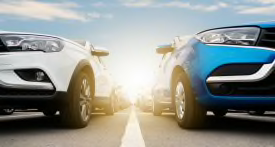The second model from Polestar may be more versatile than the Polestar 2 sedan
The Polestar 4 electric vehicle could be characterized as a tall sedan or a coupelike SUV. Either way, it blends conventional body styles, much like the Toyota Crown hybrid, to create its own balance of virtues.
The 4 looks to be more versatile, capable, and expensive than the Polestar 2. It’s positioned between the existing 2 and the coming 3 SUV, with pricing starting at $54,900.
It’s offered with two powertrain configurations, with a mild single-motor version and a wilder dual-motor, all-wheel-drive variation that’s sure to bring rapid acceleration. Thanks to a large 102-kilowatt-hour battery, the Polestar 4 boasts a 270- to 300-mile driving range.
The design looks a bit familiar from the front, sharing characteristics with other existing cars. But the real breakthrough is seen from the rear, where the absence of a back window is somewhat shocking. In its place, the 4 has a high-mounted, high-definition camera that feeds a display located in the rearview mirror.
The Polestar 4 is expected to be the first production car to feature Mobileye Chauffeur, an active driving assistance system with a full camera array and lidar (a laser-based radar system). The goal is for this optional suite to eventually go beyond hands-free driving to provide eyes-off driving. The 4 has a rather simplified interior, and its prominent center infotainment screen is powered by Google.
This is an interesting car. Let’s take a closer look.
It competes with the BMW iX, Genesis GV60, Lexus RZ, Mercedes-Benz EQE SUV, and Tesla Model Y.
















